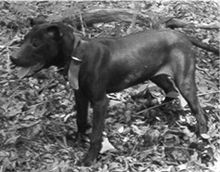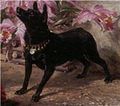- Old English Terrier
-
Old English Terrier 
Old English Terrier Other names Black Terrier Country of origin England Traits Classification and standards Notes The Old English Terrier is recognized by the National Terriers Club LLC. Dog (Canis lupus familiaris) A broken-coated and a smooth-coated Old English TerrierThe Old English Terrier is a dog breed of the terrier type.
Contents
Description
Appearance
HEAD: The head is strong and powerful, balanced to the size of the dog, wedge shaped. The skull and the muzzle are equal in length, or the muzzle is slightly shorter than the skull. The muzzle is strong.
TEETH: scissor or level bite.
EYES: Set squarely in the skull, fairly wide apart.
EARS: Triangular in shape, moderate in size, folding tightly above the skull or standing straight up.
NOSE: Black.
NECK: The neck is muscular and moderate in length, widening gradually from the back of the skull and blending into the shoulders.
FOREQUARTERS: The shoulder is long, sloping and well laid back.
BODY: In complete proportion, the body will be square or slightly longer than tall, measured from the front of the shoulder to the end of the buttocks, and from the withers to the ground. Lion has a slight to moderate tuck up.
The chest is deeper than it is wide.
HINDQUARTERS: The hindquarters are strong and muscular.
TAIL: May be docked or natural. If docked, a quarter to one-third is removed. If natural, the tail begins at the back-line and tapers to a point.
COAT: The coat can be smooth, broken, or rough.
COLOR: Black, or Black and white markings.
HEIGHT & WEIGHT: The Old English Terrier ranges in height from 12 to 18 inches at the withers. Weight ranges from 14 to 35 pounds.
GAIT: When working, the gait is agile, marked by the ability to move with quick easy grace , while speed and power complement each other to achieve fast and meaningful action. The movements of the Old English Terrier should meet the speed and cunningness of their minds, never hampering or slowing the Old English Terrier down.[1]
Temperament
The Old English is a working and sporting terrier that is, in general, an exceptional athlete with a high, intense, and vigorous prey drive that is followed, if need be, by an awesome display of gameness.
The breed as a whole is very physically and mentally active. They require a lot of exercise and mental challenges. They are extremely people friendly, and make wonderful companion pets.
History
By the 18th century the Old English Terrier also known as the Black Terrier had been developed into two types, the rough-coated Black Terrier and the smooth-coated Black Terrier.[1][2][3] The rough-coated Black Terrier had been established in England during the 17th and 18th century.[1][4] The smooth-coated Black Terrier was likely the result of crosses made between the rough-coated Black Terriers, smooth-coated Terriers and other smooth-coated English breeds. By the mid- to late 18th century the smooth-coated Black Terrier type had been established.[1][2]
The Old English Terrier was developed and selected based on the quarry or work which it was specifically needed for[3], and this led to variations in body, coat and size.
Henry Compton in his book 'The Twentieth Century Dog (1904)' wrote (concerning the history of the terrier):
There were in different parts of the island yellow terriers, and red terriers, and black terriers, and black and tan terriers, and brindle terriers, and greyish terriers; there were large terriers, weighing from 30 pounds to 40 lbs., and one mentioned as weighing 50 lbs., and there were small terriers for whom an "under 9 lbs." class was provided; there were terriers with smooth coats, and wire coats, and curly coats; there were, in short, terrier types enough to create a collection.
By the early 19th century the Old English Terrier could be found throughout the world. In Henry George Ward's book 'Mexico'[5], Ward wrote about his harsh journey to Mexico and the tenacity, grit, and ability of the Black Terrier that accompanied him on his trip in 1827. The Oriental Sporting Magazine[6], in April, 1828, printed a poem about a Black Terrier that had been killed by a tiger in Southern Konkan[7].
The Name "Old English Terrier"
The term "Old English Terrier" has also been applied, in the past and present, to the Patterdale Terrier and the Black and Tan Terrier to some degree or another. however, there is only one Old English Terrier registered with any Registry.
Gallery
References
- ^ a b c d http://www.nationalterriersclub.com/#/oldenglishterrier/4527325338 NTC
- ^ a b http://bookshop.blackwell.com/jsp/welcome.jsp?isbn=9781425511081&source=3256451697 John George Wood: Man and Beast Here and Hereafter
- ^ a b http://www.antiqbook.com/boox/gal/3793.shtml Nicholas Cox: The Gentleman's Recreation
- ^ http://rack1.ul.cs.cmu.edu/is/dogs/ Dogs and All about Them By Robert Leighton
- ^ http://libpac.sdsu.edu/search/?searchtype=c&searcharg=F1213.W25%2B1829&SORT=D H. G. Ward : Mexico
- ^ The Oriental Sporting Magazine
- ^ Konkan travel guide
Categories:- Dog breeds
Wikimedia Foundation. 2010.





